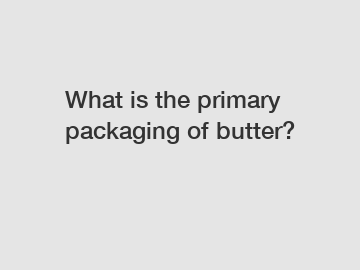What is the primary packaging of butter?
What is the primary packaging of butter? .
When it comes to butter, have you ever wondered about its primary packaging? Butter is a widely consumed dairy product that is used in various culinary applications. It is a versatile ingredient that can be spread on bread, used for cooking and baking, and even added to sauces and dressings. The primary packaging of butter plays a crucial role in preserving its freshness, flavor, and quality. Let's delve into this topic and explore the different types of primary packaging for butter.
1. Paper Wrappers:

Traditionally, butter was primarily packaged in paper wrappers. These wrappers are often made from greaseproof or parchment paper, which is resistant to grease and moisture. Paper packaging provides a classic and nostalgic feel and is still commonly used today. However, one drawback of paper wrappers is that they are not airtight, making it easier for air and other contaminants to affect the butter's quality over time.
2. Foil Wrappers:
In addition to paper, foil packaging is widely used for butter as well. Foil wrappers are made from a thin layer of aluminum that offers excellent protection against light, moisture, and oxygen. This type of packaging helps to maintain the butter's freshness and prevents it from absorbing odors from the surroundings. Foil packaging also provides a barrier against bacteria and other contaminants.
3. Plastic Tubs:
Plastic tubs are another popular primary packaging option for butter. These tubs are typically made from high-density polyethylene (HDPE) or polypropylene (PP), which are food-grade plastics known for their durability and resistance to impact. Plastic tubs offer airtight seals, ensuring the butter stays fresh for longer periods. They are generally more convenient to use, as they usually feature resealable lids that make it easy to access and store the butter.
4. Butter Sticks:
Butter sticks are a common sight in grocery stores. These sticks are often packaged in paper or foil wrappers, which are then enclosed by a larger cardboard or plastic container. This type of packaging allows for easy portioning and measuring of the butter, especially when the recipe calls for specific measurements. Butter sticks are also convenient for storage, as they can be stacked in the refrigerator without taking up much space.
In conclusion, butter can be packaged using various primary packaging options, each with its own advantages. Paper wrappers provide a classic touch but may not offer the best protection against air and contaminants. Foil wrappers, on the other hand, excel at preserving freshness and preventing odors from seeping into the butter. Plastic tubs provide a durable and airtight solution, ensuring butter stays in optimum condition for extended periods. Lastly, butter sticks offer convenience in portioning and storage. Ultimately, the choice of primary packaging for butter depends on factors such as convenience, freshness retention, and personal preference. Whether you prefer the traditional charm of paper wrappers or the convenience of plastic tubs, the primary packaging of butter plays a vital role in preserving its quality and enhancing your culinary experience.
For more Margarine container manufacturers, yogurt packaging suppliers, IML solutionsinformation, please contact us. We will provide professional answers.
298
0
0

Comments
All Comments (0)